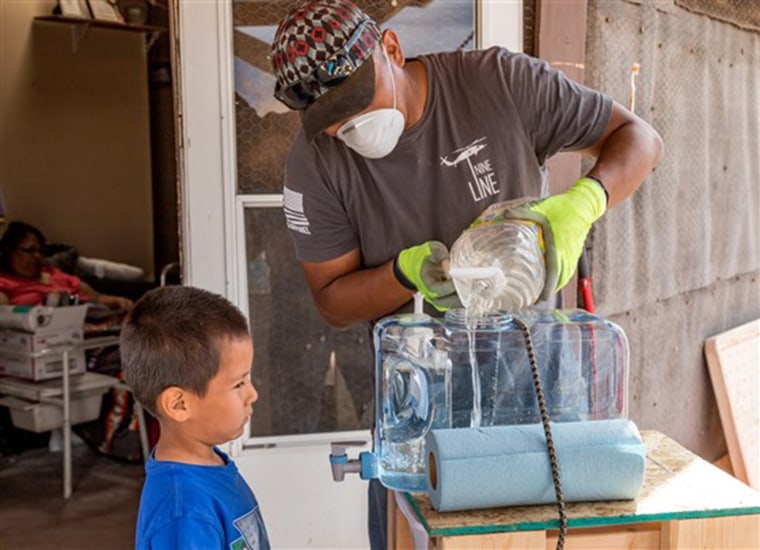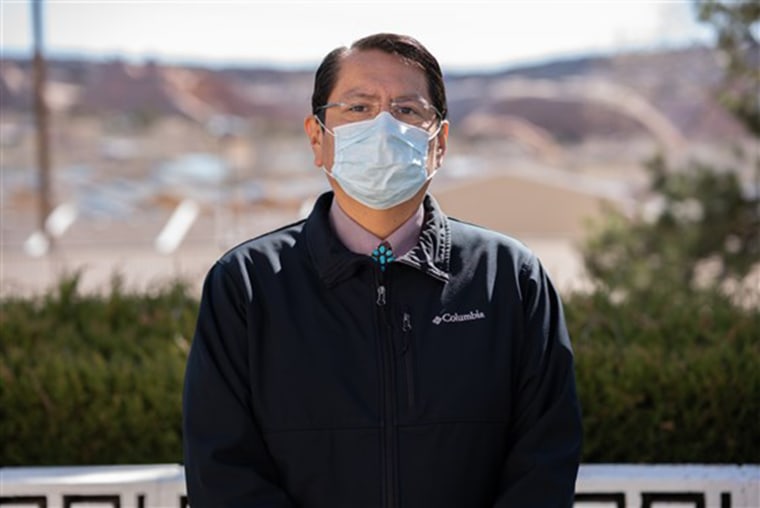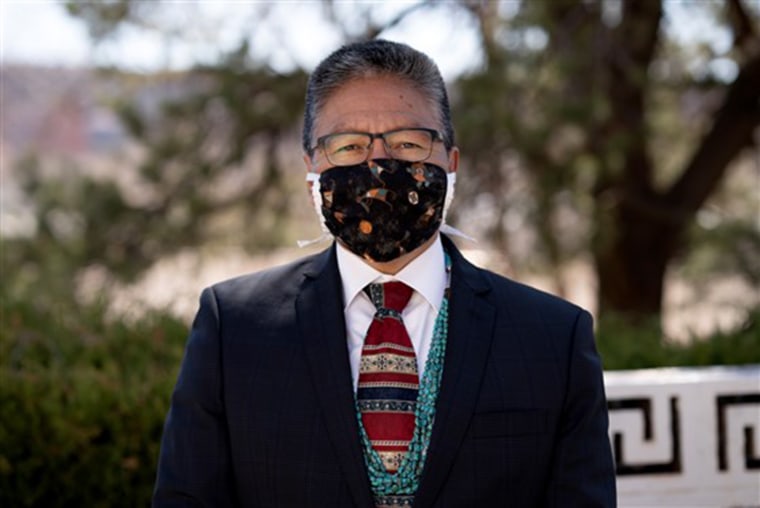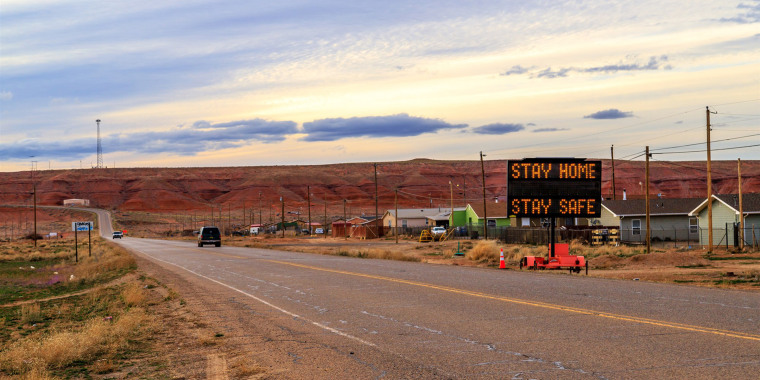On March 17, when the Navajo Nation saw its first COVID-19 case, the reservation's limited health facilities sprang into action.
"We basically changed our hospital from an acute care hospital and an ambulatory care clinic to one that could take care of respiratory care patients," said Dr. Diana Hu, a pediatrician at one of the reservation hospitals. "And that transition happened over a period of about seven days."
It didn't take long for one case to turn into two, and then 20. As of Monday, the Navajo Nation, which sprawls across three states, had 1,197 positive coronavirus cases. It has a per capita infection rate 10 times higher than that of neighboring Arizona and the third-highest infection rate in the country behind those of New York and New Jersey. Forty-four people have died, more than in 14 other states.
Download the TODAY app for the latest coverage on the coronavirus outbreak
With only 12 health care facilities across 27,000 square miles and a prevalence of chronic health issues like diabetes, the largest and most populous reservation in the U.S. is doing everything it can to cope with an outbreak that is expected to get even worse.
The fear is based on precedent. During the H1N1 flu epidemic in 2009, Native Americans died at four to five times the rate of other Americans.
"We don't know what's going to happen. We don't know if there's lasting immunity. We don't know if you can get re-infected," Hu said.
Hu said that at the Navajo-run hospital in Tuba City, Arizona, where she has practiced for 35 years, there is now a steady supply of personal protective equipment and no shortage of beds, but a 30 percent deficit in critical nursing staff means the hospital has already reached its capacity.
"We have dietitians that are in the screening tent. We have orthopedic surgeons that are doing triage," Hu said.

So far, hospitals in the Navajo Nation's hardest-hit areas have been able to transfer their most critical patients — those needing intubation and potentially weeks of care — to major hospitals in nearby cities like Phoenix and Flagstaff. But doctors worry that if those cities become inundated with their own cases, transfers might not be an option.
Full coverage of the coronavirus outbreak
"I watched the trends very, very early, and quite frankly, I was very concerned. We deal with a tremendous amount of health disparities out here, which leave us with a very vulnerable population," said Dr. Loretta Christensen, chief medical officer for the Navajo Nation at the federal government's Indian Health Service. Christensen said she's expecting a surge of new coronavirus cases in two to three weeks.
The Navajo Nation began educating its citizens earlier than many states about social distancing and hand-washing, but Christensen said part of the problem is that the advice rings hollow for many on the reservation.

"You're telling people, 'Wash your hands for 20 seconds multiple times a day,' and they don't have running water. Or you're saying, 'Go buy groceries for two or three weeks and shelter in place and don't come out,' but people can't afford groceries for two or three weeks. So it's just a setup for frustration and concern by the population here."
When combined with the comorbidities, or pre-existing conditions, that already plague the Navajo Nation — like heart disease, diabetes and obesity — public health experts worry that difficulty accessing basic needs like food and water is going to compound the crisis.
"Our federal government, since treaties were signed in the late 19th and early 20th century, has broken promise after promise after promise," said Allison Barlow, director of the Center for American Indian Health, or CAIH, at Johns Hopkins University's Bloomberg School of Public Health. "And what we're seeing today is the accumulation of those broken promises and where it has left people."
"There has been chronic underfunding of the health systems and infrastructure, from electricity to plumbing to water supplies. All of these things are inflaming the COVID epidemic right now," Barlow said.
To help alleviate the frustrations, CAIH and other public health groups that have long been active on the reservation are stepping in.
CAIH is building hand-washing stations for citizens without running water and delivering care packages of food, water and cleaning supplies to remote homes and the elderly.
The Community Outreach and Patient Empowerment program, or COPE, a nonprofit focused on native health that grew out of Brigham and Women's Hospital in Boston a decade ago, has helped turn local motels into respiratory care facilities for the homeless population in Navajo country.

Both CAIH and COPE are supporting the Indian Health Service with contact-tracing, and both organizations, which operate on donations and grants alone, estimate that their monthly costs for health activities on the reservation have doubled during the pandemic.
The U.S. government funds tribal health care, as agreed upon in historic treaties between the U.S. and American Indian tribes, but the Navajo Nation — among other tribal nations — has faced crippling delays in receiving emergency funding.
Download the TODAY app for the latest coverage on the coronavirus outbreak
Since COVID-19 began sweeping across Indian country five weeks ago, the Navajo Nation has spent $4 million from its own coffers, President Jonathan Nez told NBC News.
"I'm keeping all these receipts, because after this emergency operation, I'll be giving those receipts to Uncle Sam for a full reimbursement," Nez said. He noted that traditional sources of revenue for the tribal nation, like its casino and coal mine, have been shut down because of the virus.
Nez said that federal funds finally began to trickle into the tribal nation earlier this month and that Indian Health Service facilities received rapid-response tests and additional ventilators, but he said they still need more assistance.
"These dollars that were allocated by Congress and signed into law by the president are monies to help U.S. citizens," he said. "And, you know, it just seems alarming that the first citizens of this country are kind of pushed to the back burner."
On Thursday, the tribal nation made the unprecedented move of putting out a public call for donations, asking for money as well as supplies like N95 masks, hand sanitizer and thermometers for health care workers and the community.
Friday marked the deadline for the 574 tribal nations to submit their requests for funds from an $8 billion sum that was appropriated for American Indian tribes as part of the March coronavirus stimulus package known as the CARES Act. Tribal nations have been told that those funds will be disbursed by Friday.
"We are a sovereign nation, but we're a ward of the federal government, and so we have to wait until decision-makers are able to, I guess, collaborate and agree upon themselves that this is the time to assist Indian Country," Navajo Nation Vice President Myron Lizer said.
For health care providers like Hu in Tuba City, that means hoping for the best and preparing for the worst.
"We're kind of feeling like we're at maybe mile 3.5. We've had the sprint start, and we kind of have to pace ourselves. So what we're doing is we're trying to strategize," she said. "Let's hope that the flattening of the curve occurs so we don't overwhelm anyone in the medical systems, but if we don't, let's plan as if we need to keep this on until September."
